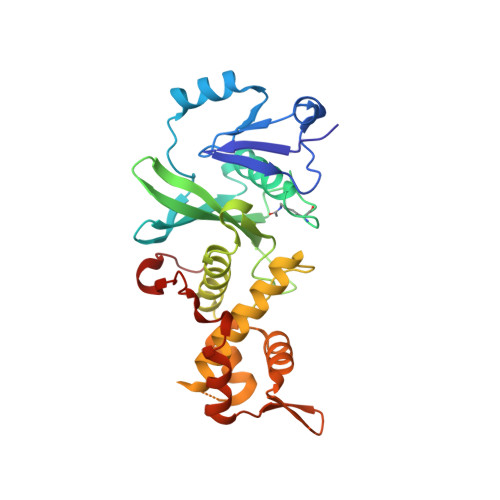Discovery of Acylsulfonohydrazide-Derived Inhibitors of the Lysine Acetyltransferase, KAT6A, as Potent Senescence-Inducing Anti-Cancer Agents.
Priebbenow, D.L., Leaver, D.J., Nguyen, N., Cleary, B., Lagiakos, H.R., Sanchez, J., Xue, L., Huang, F., Sun, Y., Mujumdar, P., Mudududdla, R., Varghese, S., Teguh, S., Charman, S.A., White, K.L., Shackleford, D.M., Katneni, K., Cuellar, M., Strasser, J.M., Dahlin, J.L., Walters, M.A., Street, I.P., Monahan, B.J., Jarman, K.E., Jousset Sabroux, H., Falk, H., Chung, M.C., Hermans, S.J., Downer, N.L., Parker, M.W., Voss, A.K., Thomas, T., Baell, J.B.(2020) J Med Chem 63: 4655-4684
- PubMed: 32118427
- DOI: https://doi.org/10.1021/acs.jmedchem.9b02071
- Primary Citation of Related Structures:
6OWH, 6OWI, 6PD8, 6PD9, 6PDA, 6PDB, 6PDC, 6PDD, 6PDE, 6PDF, 6PDG - PubMed Abstract:
A high-throughput screen designed to discover new inhibitors of histone acetyltransferase KAT6A uncovered CTX-0124143 ( 1 ), a unique aryl acylsulfonohydrazide with an IC 50 of 1.0 μM. Using this acylsulfonohydrazide as a template, we herein disclose the results of our extensive structure-activity relationship investigations, which resulted in the discovery of advanced compounds such as 55 and 80 . These two compounds represent significant improvements on our recently reported prototypical lead WM-8014 ( 3 ) as they are not only equivalently potent as inhibitors of KAT6A but are less lipophilic and significantly more stable to microsomal degradation. Furthermore, during this process, we discovered a distinct structural subclass that contains key 2-fluorobenzenesulfonyl and phenylpyridine motifs, culminating in the discovery of WM-1119 ( 4 ). This compound is a highly potent KAT6A inhibitor (IC 50 = 6.3 nM; K D = 0.002 μM), competes with Ac-CoA by binding to the Ac-CoA binding site, and has an oral bioavailability of 56% in rats.
Organizational Affiliation:
Medicinal Chemistry, Monash Institute of Pharmaceutical Sciences, Monash University (Parkville Campus), Parkville, Victoria 3052, Australia.



















